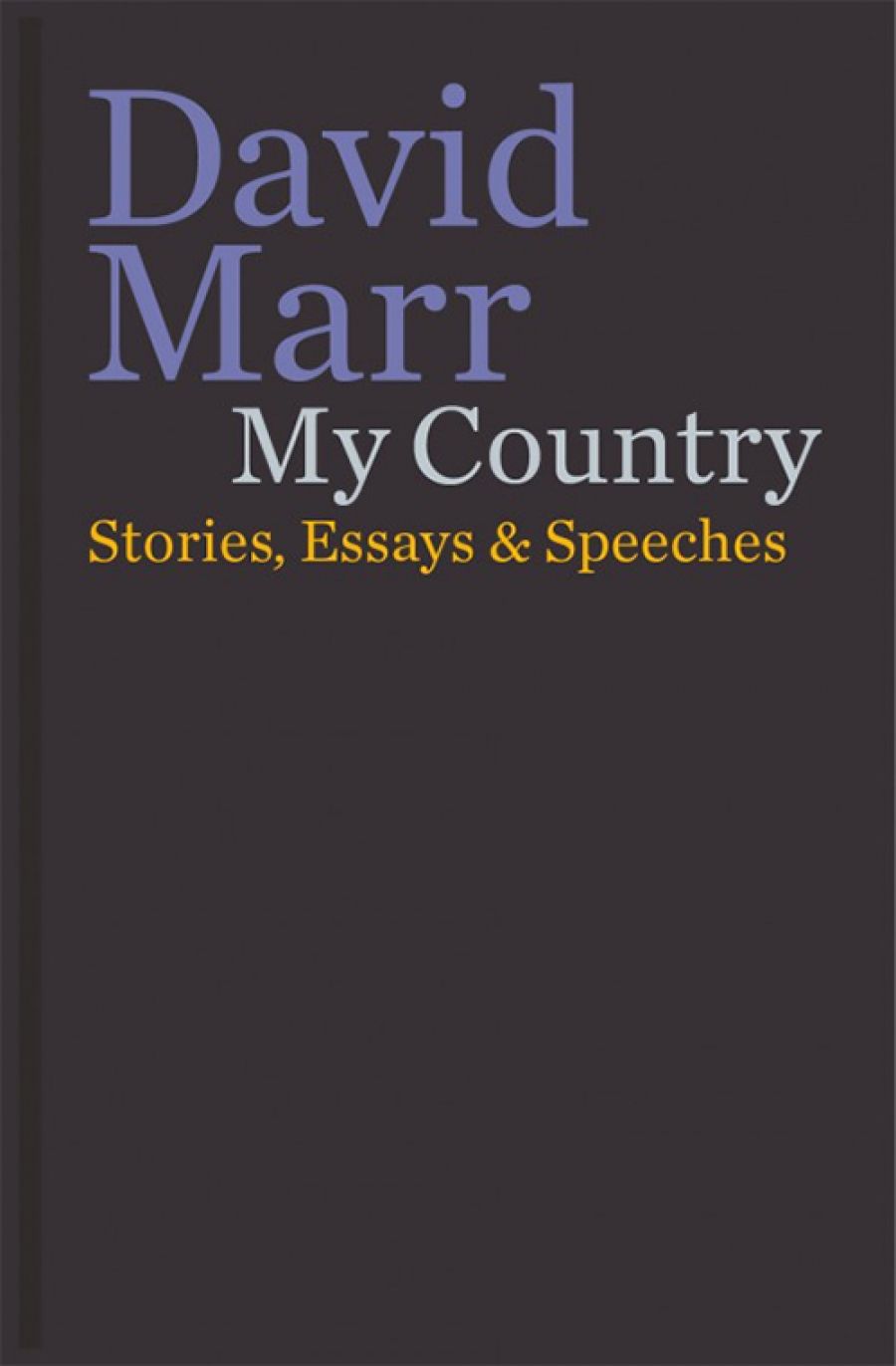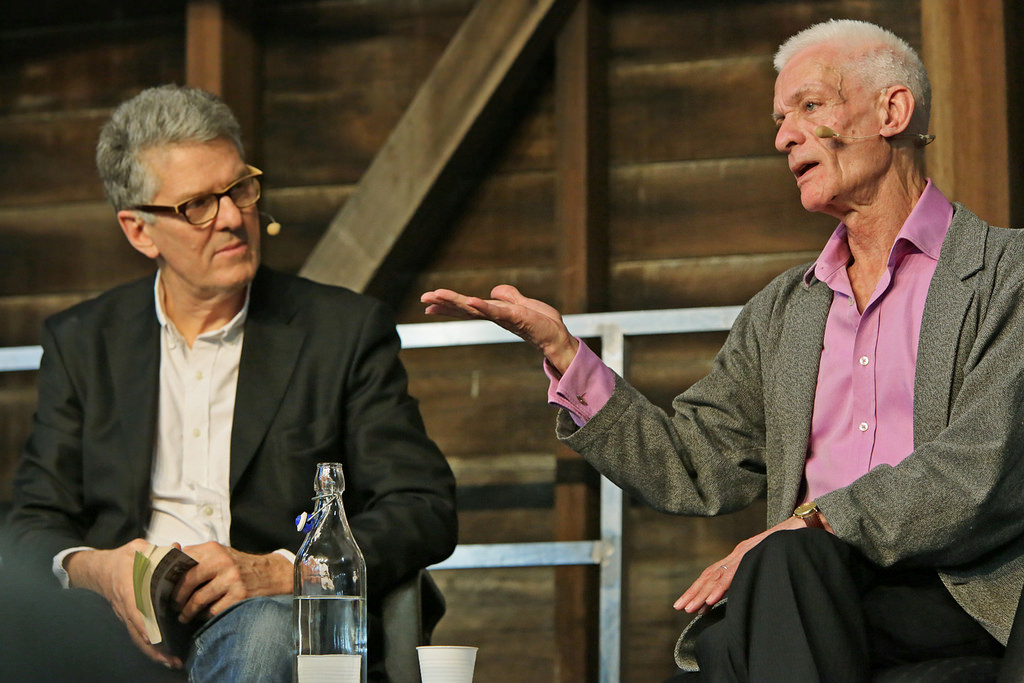
- Free Article: No
- Contents Category: Essay Collection
- Custom Article Title: Glyn Davis reviews 'My Country' by David Marr
- Custom Highlight Text:
There was excitement. David Marr, newly appointed editor of the National Times at just thirty-three, had agreed to speak with politics students on campus. Volunteers were dispatched to buy the obligatory felafel and cheese, plastic cups, and cask wine, and at 3 pm the famous journalist arrived to address ...
- Book 1 Title: My Country
- Book 1 Biblio: Black Inc., $39.99 hb, 400 pp, 9781760640804
We were not disappointed. Stories of Whitlam and Fraser, speculation about the October 1980 federal poll, at the time only weeks away, encouragement for anyone considering journalism as a career. We noticed the legal turn of phrase from a man who worked only a single day as a solicitor before he turned to writing. He said little about himself, much about the times.
I left impressed at the breadth and insight. A lifetime later, My Country fills in the blanks, the decades as a political journalist and commentator. This generous collection, more than five hundred pages of text, draws together Marr’s writings from 1974 to late 2018. There are occasional extracts from books and Quarterly Essays, but much of the material is short-form journalism, extracts from a long career with the National Times and the Sydney Morning Herald, more recent pieces from the Guardian, speeches, and obituaries. The material conveys Marr’s preoccupations: politics first; speculation about the Australian character; the experience of a gay man from the violence of the first Mardi Gras to weeping at the marriage equality referendum. There is literature, much on his beloved Sydney, biographical studies, sidelines into architecture, and those legal interests first glimpsed in a Besser-brick seminar room at the University of New South Wales.
This time we learn something about the person. His origins in the ‘sheltered Protestant North Shore of Sydney’, doubts about faith from his school years, an early marriage and its eventual dissolution, the long process of coming out, life with a partner. The death of parents is movingly recounted, the links to family underscored, with the chilling observation that we all die in character.
Sadly, there is less on student years or intellectual formation. Six years at university were not wasted, Marr assures us, because ‘university offers us dead ends to explore, to discover what we are, certainly, but also to find out what we are not’. Marr realised quickly he was not a practising lawyer, and moved instead to journalism – early years on The Bulletin, immersion in that now largely vanished world of newsrooms and reporters, compositors and editors, the years hosting Media Watch.
Personal revelation, it turns out, is incidental to the concern of the volume. The focus is captured in the book title – a continuous if discursive speculation on what it means to be Australian. So we learn that Australians ‘muddle through, hoping and trusting’. We are neither talented at great gestures nor impressed by abstractions such as justice and liberty. Sometimes tolerant, even passive, we put up with our leaders. When we behave well, suggests Marr, we can demonstrate a commitment to fairness and good sense.
The asides on the Australian character often illuminate some key failings. We see ourselves as compassionate but treat asylum seekers appallingly. We are easy going but fail to be angry when small children suffer. We laugh at institutions but tolerate their cruelty. Marr can be wry or mocking, gentle in unexpected places, yet angry at moralists who impose views on the wider society. Marr is a man who loves Australians and grieves when we disappoint.
This is most evident when talking about race. As Marr argues, ‘the issue of race – immigrant and Aboriginal – has hardly ever been off the political agenda’. An extended excursion into the Federation debate of February 1898 suggests a nation formed from fear of uncontrolled Chinese migration. Despite several chapters on Pauline Hanson – Kabuki with red hair, says Marr – his most passionate text is focused on John Howard and race issues. He pays tributes to Howard’s formidable political skills while decrying the consequences. In parliament, Howard was ‘a truly formidable debater but his great skill fail[ed] him when complex moral issues [were] at stake’.
Given the time spanned by the book, John Howard looms large. Marr believes the long-serving prime minister ‘put a shaft into the core of this country, and up came race’. Howard is a ‘genius of sorts’ because he has no illusions: he sees Australians as they really are. In turn, ‘Howard never surprises. He’s always himself.’ Howard could speak to the electorate about identity, tracking alongside Hanson without needing to adopt her crude slogans.
 John Howard listening to a question at the DFAT Policy Forum, 2014 (photo by Robert Keating/DFAT/Wikimedia Commons)
John Howard listening to a question at the DFAT Policy Forum, 2014 (photo by Robert Keating/DFAT/Wikimedia Commons)
It is an assessment that Howard would contest, and Marr acknowledges his views in an extended article on faith and race. Blaming leaders does not exonerate others. ‘Racism,’ concludes Marr, ‘is so subtle that no white Australian can really claim to be untouched by that mix of shame, boredom and fear that has marked white response to black from the start.’
Though Marr travels through the book, from Christmas Island to Hill End, his world is Sydney. He revels at times in the corruption, the bright sights, and the gaucheness of ‘the irresistible city’, one of the richest places on earth, a global centre without a hinterland. A city that loves winners, its glorious harbour a symbol of good fortune. Marr can rage about the inequities of his hometown, but ‘no other city here could be so exciting, so funny and alive’. Sydney can be whatever we want it to be – reinvention accompanied by ‘massed fireworks and a good dose of amnesia’.
Like many Sydneysiders, David Marr enjoys a scandal. There are literary controversies and court cases. Harry Seidler sues cartoonist Patrick Cook, Peter Costello sues Bob Ellis, and Chris Kenny pursues the ABC. We dwell on Chris Mitchell and the Order of Lenin, and savour moral panic over Bill Henson’s photographs. There is cesorship to explore, Andrew Bolt to embarrass, and cash for comment with John Laws and Alan Jones (a ‘very Sydney tale’ we learn).
Then there are people. Portraits abound. There are vignettes on the death of Ben Chifley, the women in John Kerr’s life, the funeral of Gough Whitlam, John Howard’s father, the rise of John Gorton, Kim Beazley’s 2001 election campaign. Over decades, Marr has honed his biographical skills. Here are fine portraits of Robert Dessaix, David Malouf, Robert Manne, and the long widowhood of Manoly Lascaris.
 David Marr and Robert Dessaix at the 2012 Sydney Writers' Festival (photo by Prudence Upton)
David Marr and Robert Dessaix at the 2012 Sydney Writers' Festival (photo by Prudence Upton)
Because this is primarily a collection of journalism, we miss some significant, longer biographies by Marr. We learn about his interaction with Patrick White but see nothing from one of Australia’s finest literary biographies, Marr’s Patrick White: A life (1991). There are fragments only from the early portrait of Sir Garfield Barwick. Instead, the volume focuses on political encounters. Marr likes to be face to face with his subjects, often using a single moment to illuminate something larger about a person and their context. This can be compelling, as when Marr interviews Arne Rinnan, captain of the Tampa. How does Australia look to a man who rescued 438 distressed people at sea only to be prevented from landing them?
Relying on brief encounters can also misfire. Perhaps Bill Shorten was not available for interview, but it was hard to glean much about him from a long extract on factional politics in the Victorian ALP. The material on Kevin Rudd, much cited when Rudd was deposed as prime minister, sees Marr provoke anger and then describe it as core to Rudd’s character. Well, maybe, but likely not. Rosebud may be more plausible in film than in life.
Alongside biography are substantive articles on an impressive range of topics. Marr tests the origins of prejudice against homosexuality and the political struggle for gay rights in the United States and Australia. These longer pieces often demonstrate detailed research to make a wider point. A description of a war memorial designed by Sir Edwin Lutyens traces continuities in Australian treatment of visionary architects, from Walter Burley Griffin to Jørn Utzon. Australia is illuminated from different angles in writing ranging film-maker Stanley Hayes, the 1967 referendum and its aftermath, the imprisonment of Dr Mohamed Haneef, corruption at the Australian Wheat Board, and, powerfully, the abuse of the young in Jewish and Catholic institutions exposed by a Royal Commission.
A collection of works drawn over forty-five years will always present challenges of coherence. Marr acknowledges he has trimmed in places, even taken an axe to some pieces, while working alongside publisher Chris Feik from Black Inc. Given the volume of material, there is surprisingly little overlap and only occasional puzzlement about an inclusion. More striking is the consistency in tone and intelligence. Journalism is a response to the moment, but cumulatively it can illuminate a whole period. By questioning who we are, My Country proves coherent across its ambitions.
 David Marr (photo via Black Inc.)There are no explicit conclusions, but at least two readings are possible. First, threaded through many different articles is a sense of the Australia Marr would like to see: a democracy that is a ‘contest of conversations’, a dialogue ‘between a nation and its leaders’, a nation ‘more open, more tolerant, more reconciled to Indigenous Australians, more attuned to Asia, more in love with the arts, a great independent republic in the south’. Give him a place ‘free, open, principled, fearless, fair’.
David Marr (photo via Black Inc.)There are no explicit conclusions, but at least two readings are possible. First, threaded through many different articles is a sense of the Australia Marr would like to see: a democracy that is a ‘contest of conversations’, a dialogue ‘between a nation and its leaders’, a nation ‘more open, more tolerant, more reconciled to Indigenous Australians, more attuned to Asia, more in love with the arts, a great independent republic in the south’. Give him a place ‘free, open, principled, fearless, fair’.
Do we rise to this vision splendid? ‘I know my country now,’ says David Marr. Far from perfect, it is ‘a wonderfully muddled, lively society that happily accepts all sorts of confusion and contradiction. We’re real, relaxed and alive.’ Perhaps that is why ‘we always come good in the end’.


Comments powered by CComment